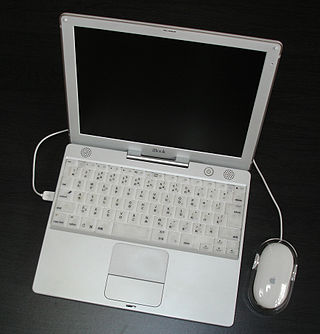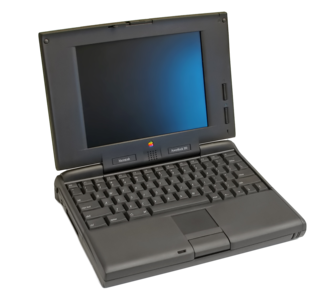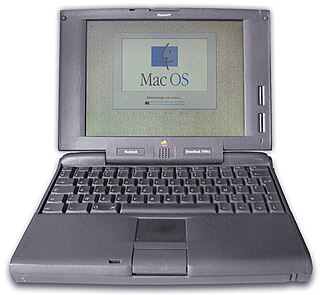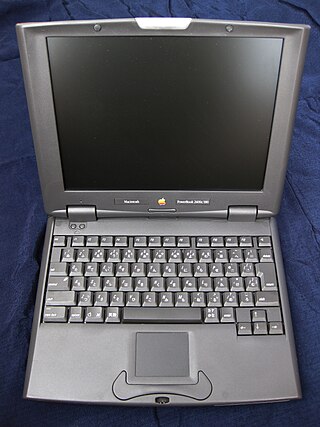
The Power Macintosh, later Power Mac, is a family of personal computers designed, manufactured, and sold by Apple Computer, Inc as the core of the Macintosh brand from March 1994 until August 2006.

The PowerBook is a family of Macintosh laptop computers designed, manufactured and sold by Apple Computer from 1991 to 2006. During its lifetime, the PowerBook went through several major revisions and redesigns, often being the first to incorporate features that would later become standard in competing laptops. The PowerBook line was targeted at the professional market. In 1999, the line was supplemented by the home and education-focused iBook family.

iBook is a line of laptop computers designed, manufactured, and sold by Apple Computer from 1999 to 2006. The line targeted entry-level, consumer and education markets, with lower specifications and prices than the PowerBook, Apple's higher-end line of laptop computers. It was the first mass consumer product to offer Wi-Fi network connectivity, which was then branded by Apple as AirPort.

The Power Macintosh G3 is a series of personal computers designed, manufactured, and sold by Apple Computer from November 1997 to August 1999. It represented Apple's first step towards eliminating redundancy and complexity in the product line by replacing eight Power Macintosh models with three: Desktop and Mini Tower models for professional and home use, and an All-In-One model for education. The introduction of the Desktop and Mini Tower models coincided with Apple starting to sell build-to-order Macs directly from its web site in an online store, which was unusual for the time as Dell was the only major computer manufacturer doing this. Apple's move to build-to-order sales of the Power Macintosh G3 also coincided with the acquisition of Power Computing Corporation, which had been providing telephone sales of Macintosh clones for more than two years.

SuperDrive is the product name for a floppy disk drive and later an optical disc drive made and marketed by Apple Inc. The name was initially used for what Apple called their high-density floppy disk drive, and later for the internal CD and DVD drive integrated with Apple computers. Though Apple no longer manufactures computers that feature built-in SuperDrives, the name is still used when referring to Apple's external CD and DVD drive accessory (pictured).

The Power Mac G4 is a series of personal computers designed, manufactured, and sold by Apple Computer from 1999 to 2004 as part of the Power Macintosh line. Built around the PowerPC G4 series of microprocessors, the Power Mac G4 was marketed by Apple as the first "personal supercomputers", reaching speeds of 4 to 20 gigaFLOPS. This was the first existing Macintosh product to be officially shortened as "Mac", and is the last Mac able to boot into classic Mac OS.

The PowerBook G3 is a series of laptop Macintosh personal computers designed, manufactured, and sold by Apple Computer from 1997 to 2001. It was the first laptop to use the PowerPC G3 (PPC740/750) series of microprocessors, and was marketed as the fastest laptop in the world for its entire production run. The PowerBook G3 was succeeded by the PowerBook G4.

The Macintosh TV is a personal computer with integrated television capabilities released by Apple Computer in 1993. It was Apple's first attempt at computer-television integration. It shares the external appearance of the Macintosh LC 500 series, but in black. The Macintosh TV is essentially a Performa 520 that can switch its built-in 14" Sony Trinitron CRT from being a computer display to a cable-ready television. It is incapable of showing television in a desktop window, although it can capture still frames to PICT files.

The Power Macintosh 6100 is a personal computer designed, manufactured and sold by Apple Computer from March 1994 to March 1996. It is the first computer from Apple to use the new PowerPC processor created by IBM and Motorola. The low-profile ("pizza-box") case was inherited from the Centris/Quadra 610 and 660AV models, and replaced the Macintosh Quadra series that used the Motorola 68040 processor, Apple's previous high-end workstation line.

The PowerBook 500 series is a range of Apple Macintosh PowerBook portable computers first introduced by Apple Computer with the 540c model on May 16, 1994. It was the first to have stereo speakers, a trackpad, and Ethernet networking built-in.

The PowerBook 190 and its companion PowerBook 190cs are laptop computers manufactured by Apple Computer as part of their PowerBook brand, introduced to the market in August 1995. The two models differ only in their screen: the 190 had a 9.5" greyscale display, while the 190cs featured a 10.4" color display. Apple's target sales audience for this model was the college student in need of a no-frills portable computer.

The PowerBook 3400c is a laptop computer in the PowerBook line manufactured by Apple Computer from February to November 1997. It was briefly the fastest laptop in the world. Using the PowerPC 603e processor running at speeds of up to 240 MHz, this PowerBook was the first to feature a PCI architecture, EDO memory, and a 64-bit wide, 40 MHz internal bus. It was also the first PowerBook to feature a PC card slot capable of being used as a zoomed video port. Like all Apple laptops since the PowerBook 500 series, it featured a built-in trackpad as the pointing device.

The PowerBook 5300 is the first generation of PowerBook laptops manufactured by Apple Computer to use the PowerPC processor. Released in August 1995, these PowerBooks were notable for being the first to feature hot-swappable expansion modules for a variety of different units such as Zip drives; PC Card slots as standard; and an infrared communication port. In common with most preceding Macintosh portables, SCSI, Serial, and ADB ports were included as standard. An internal expansion slot was also available for installing a variety of modules including Ethernet and video cards to drive a second monitor in mirroring or dual-screen modes.

The Power Macintosh 9500 is a personal computer designed, manufactured and sold by Apple Computer from June 1995 to February 1997. It is powered by a PowerPC 604 processor, a second-generation PowerPC chip which is faster than the PowerPC 601 chip used in the Power Macintosh 8100. The 180MP and 200 MHz models, introduced August 1996, use the enhanced PowerPC 604e processor.

The Power Macintosh 6200 is a series of personal computers designed, manufactured, and sold by Apple Computer from May 1995 to July 1997. The 6200 is the PowerPC-based replacement for the Quadra 630, with the same form factor and price range. In early 1997, the rather different Power Macintosh 6300/160 / Performa 6360 based on the Power Macintosh 6400 was introduced. The whole line was discontinued when the desktop model of the Power Macintosh G3 was released.

The Power Macintosh 7300 is a personal computer designed, manufactured and sold by Apple Computer from February 1997 to November 1997. It was introduced with 166, 180 and 200 MHz CPUs in February 1997 alongside the Power Macintosh 8600 and 9600. The 7300 replaced both the Power Macintosh 7200 and 7600, replacing the only remaining first-generation PowerPC system in Apple's lineup. MacUser Magazine's review says the 7300 "offers the most satisfying improvement" of the new machines introduced in early 1997 due to a significant performance jump from its predecessors, as well as offering 50% faster CD-ROM and hard disk space. The 7300 was replaced by the Power Macintosh G3 desktop model in November 1997. Workgroup Server 7350 continued to be sold until March 1998 when the Macintosh Server G3 was introduced.

The PowerBook 2400c is a subnotebook in Apple Computer's PowerBook range of Macintosh computers, weighing 4.4 pounds (2.0 kg). Manufacturing was contracted to IBM Japan. In a return to the PowerBook 100 form factor, it was introduced in May 1997 as a late replacement for the PowerBook Duo 2300c, which had been the last of the subnotebook PowerBook Duo series. The 2400c was discontinued in March 1998, with no immediate replacement — the model that followed it was the much larger PowerBook G3 Series. However, in Japan a 2400c with a 240 MHz CPU was offered shortly after the original model's discontinuation, until the end of the year.

The Power Macintosh 5500 is a personal computer designed, manufactured, and sold by Apple Computer from February 1997 to March 1998. Like the Power Macintosh 5260 and 5400 that preceded it, the 5500 is an all-in-one design, built around a PowerPC 603ev processor operating at 225, 250 or 275 megahertz (MHz).

IBM ThinkPad 760 was a notebook computer introduced in 1995 by the IBM corporation into the market as part of the ThinkPad 700-series. It was succeeded in 1998 by the ThinkPad 770 series.
The classic Macintosh startup sequence includes hardware tests which may trigger the startup chime, Happy Mac, Sad Mac, and Chimes of Death. On Macs running macOS Big Sur or later the startup sound is enabled by default, but can be disabled by the user within System Preferences or System Settings (Ventura).




















